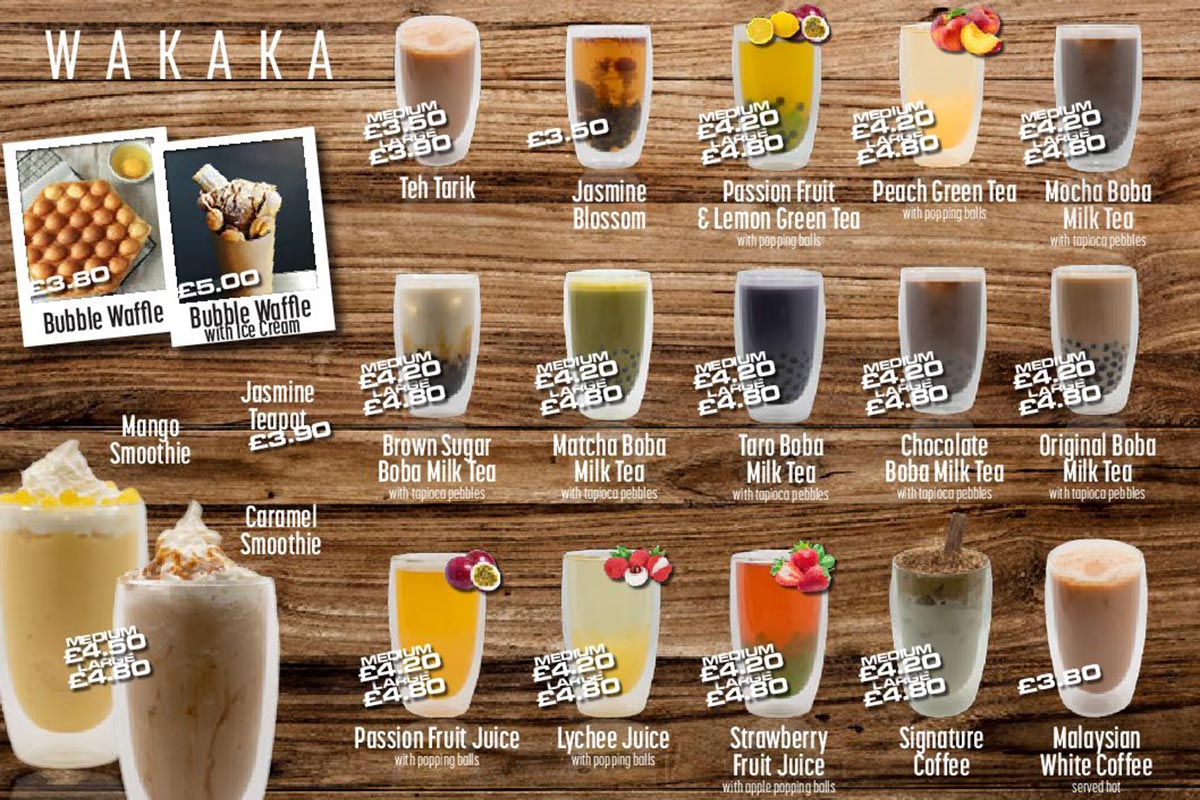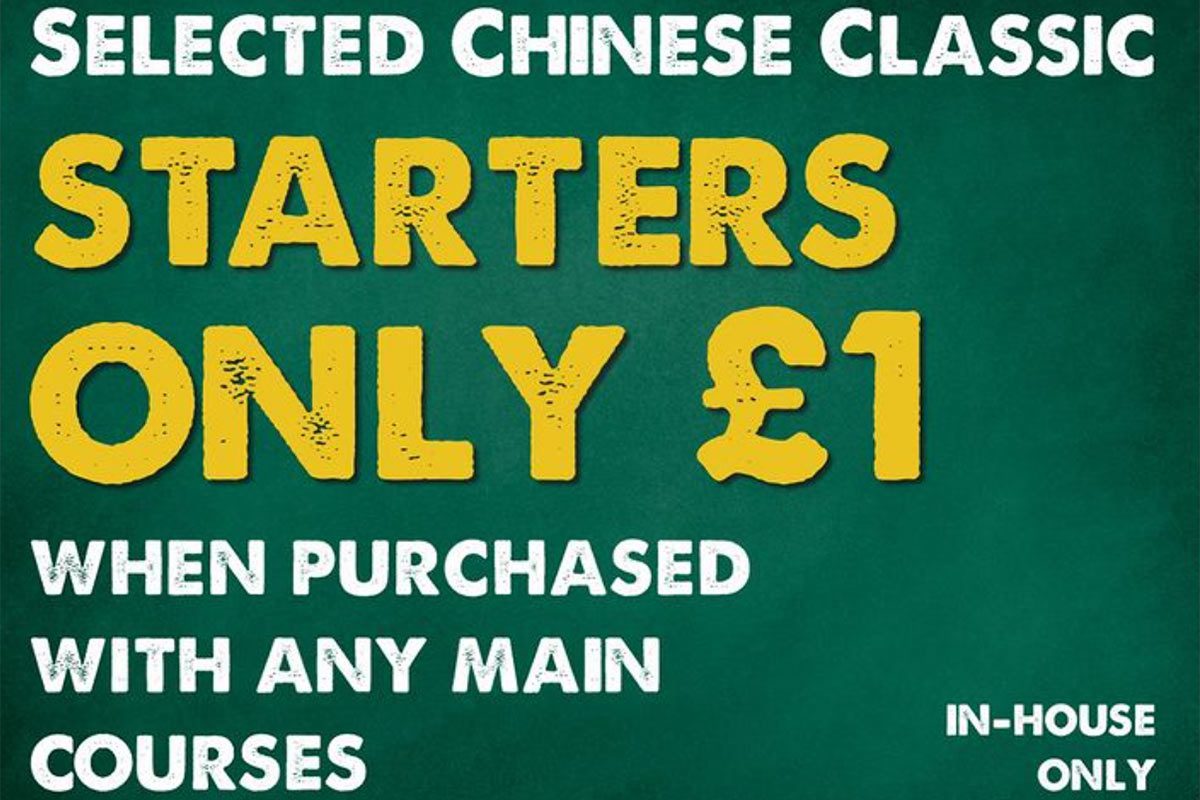
Bubble Tea in Shrewsbury
Dive into the heart of Asian culture with every sip at Wakaka Street Food. Our bubble tea, a beloved Taiwanese sensation, promises a drink and an exhilarating journey. Made with premium tea leaves, caressed with luscious flavours, and paired with the delightful chew of perfectly crafted tapioca pearls, each cup embodies the spirit of the streets it originated from. At Wakaka, we don’t just serve bubble tea; we bring you authenticity, passion, and a sprinkle of adventure. Unveil the magic of the East in a glass only at Wakaka.
What is bubble tea?
Bubble tea, often called “boba tea”, is a delightful concoction that has taken the world by storm. This drink, characterised by its chewy tapioca pearls and rich flavours, traces its origins back to Taiwan in the 1980s. Let’s delve into its colourful history:
Taiwan in the 1980s:
The birthplace of bubble tea is Taiwan, an island known for its rich tea culture. It was in the 1980s when innovative tea shop owners began experimenting with their traditional tea offerings, hoping to attract a younger crowd. The exact origin story has a few variations, but two stories stand out:
Taichung City: According to some accounts, Lin Hsiu Hui, a product development manager at the Chun Shui Tang tea house in Taichung, was the first to pour a sweetened pudding with tapioca balls into her iced tea during a staff meeting in 1988. This experiment turned out to be a hit, leading the tea house to add it to the menu, where it quickly gained popularity.
Tainan City: Another story credits Hanlin Tea Room in Tainan. The owner, Tu Tsong-he, saw white tapioca pearls in the market in the early 1980s and added them to his cold milk tea, creating a unique visual and taste appeal.
Despite these conflicting narratives, what’s clear is that by the late 1980s and early 1990s, this innovative drink began spreading like wildfire throughout Taiwan.
The Name Bubble Tea
The term “bubble” in bubble tea doesn’t refer to the tapioca pearls but to the bubbles formed when the tea, milk, and flavoured syrup are shaken together. However, with the rise in popularity of the drink, many associate the “bubble” with the tapioca pearls or “boba” (which means “big pearls” in Chinese).
Global Phenomenon
By the 2000s, bubble tea began its journey beyond the shores of Taiwan, making its way to other Asian countries and eventually to the West. Cities with significant Asian populations, like Los Angeles, Vancouver, and London, were among the first to embrace this delightful drink. Its unique combination of flavours and textures, coupled with the customisable nature of the drink (from the tea base sweetness level to the various toppings), made it an international favourite.
Today, bubble tea shops can be found in nearly every corner of the world, each offering its unique spin on this Taiwanese classic. The drink’s global appeal is a testament to its versatility, and its roots in Taiwan remain a source of pride for many.
Ingredients & Varieties of Bubble Tea
Bubble tea’s enchanting allure lies in its rich flavours, diverse textures, and the sheer joy of customisation. The drink has evolved considerably since its Taiwanese inception, leading to a plethora of varieties around the globe. Let’s unravel the delightful components that make up this beverage.
Essential Components of Bubble Tea
Tea Base: At its core, bubble tea starts with a tea base. The tea can be black, green, oolong, or white, brewed strong to stand up to the other ingredients.
Sweetener: Sugar syrup, honey, or agave, among other sweeteners, can be used. The sweetness level can often be adjusted to one’s preference, ranging from unsweetened to extra sweet.
Milk or Creamer: While not all bubble teas are milky, many include milk, non-dairy creamers, or condensed milk. This component gives the drink its creamy texture.
Ice: Served cold, ice is added to refresh the tea, though hot variations of bubble tea are also available.
Different Types of Tea Bases and Flavors:
Black Tea: A classic base, it’s robust and can be paired with a myriad of flavours like chocolate, caramel, or even spiced versions like masala chai.
Green Tea: Often paired with fruit syrups due to their fresh and slightly astringent quality. Popular flavours include honeydew, lychee, and passionfruit.
Oolong Tea: Known for its fragrant and floral notes, flavours like peach or rose to complement it wonderfully.
White Tea: A delicate choice, it is best when lightly flavoured to preserve its subtle character – often enjoyed with light fruit infusions like pear or mango.
Herbal and Fruit Teas: While non-traditional, these bases have gained popularity, especially for caffeine-free versions. Hibiscus, chamomile, and rooibos are some examples.
Popular Add-ins:
Tapioca Pearls (Boba): These chewy, round balls made from tapioca starch are the most iconic add-in. They can be small (like pearls) or larger (like the classic boba).
Jellies: Fruit or grass jellies are common and come in various flavours like coconut, lychee, and rainbow.
Pudding: A creamy, flan-like texture that’s sweet and smooth.
Agar Pearls: Similar to tapioca pearls but made from agar, a plant-based gelatin substitute.
Fruit Bits: Pieces of fruit, often matching the flavour of the tea, add freshness and bite.
Chia Seeds or Basil Seeds: For a healthful twist, these add texture and a slight crunch.
Bubble tea’s beauty lies in its versatility. Whether you’re in the mood for something classic or adventurous, a bubble tea blend awaits you, ready to tantalise your taste buds.
Making Bubble Tea
Bubble tea, affectionately called boba tea, has not just quenched thirsts but also warmed hearts across the globe. This intriguing mix of tea, milk, and tapioca pearls offers a delightful dance of flavours and textures in every sip. Here’s how to embark on the delightful journey of making this iconic drink:
A Simple Step-by-Step Process:
Tea Brewing
- Start by boiling water.
- Steep your preferred tea – black tea, green tea, or Earl Grey. The steeping duration typically spans 3 to 5 minutes, but variations can occur depending on the type of tea.
- Post brewing, remove the tea leaves, allowing the tea to cool. Using cold water or ice can expedite this cooling process.
Preparing the Boba Pearls (Tapioca Balls)
- In another pot, set the water to boil.
- As it reaches boiling point, introduce the tapioca balls. Let these little balls simmer until they achieve a deliciously chewy consistency, roughly within 20-30 minutes.
- Once done, drain the pearls and allow them a brief cooling period.
- For a touch of sweetness, mix them in brown sugar syrup or even maple syrup for that glossy, appetising sheen.
Assembling the Bubble Tea Drink
- In a shaker, blend the brewed tea with your choice of sweetener. This could range from sugar syrup to brown sugar. Additionally, decide on your creamer – milk, condensed milk, oat milk, or any other non-dairy milk.
- Vigorously shake until a frothy layer graces the top.
- Into a glass, serve the prepared tapioca pearls first.
- Elegantly pour the vigorously shaken tea mixture over these pearls.
- Feel free to personalise with additional toppings or enhancements.
Armed with a large boba straw, penetrate the seal of your boba drink. For all the boba lovers, now’s the time to relish your handmade bubble tea sensation!
The Cultural Significance of Bubble Tea
Since its origins in the tea shops of Taiwan, bubble tea, also lovingly called boba tea, has transformed into a global icon of modern Asian culture. This drink, characterised by its chewy tapioca pearls—often called boba pearls or tapioca balls—submerged in a mix of milk tea, is more than just a tantalising treat; it’s a cultural emblem.
Bubble Tea’s Role in Modern Asian Culture
Symbol of Youth and Urbanisation: In today’s age, bubble tea shops or boba shops aren’t just places to serve bubble tea; they’re social hubs echoing with laughter and youthful chatter. Much like coffee shops in Western cultures, these establishments have become the rendezvous points for the younger generation in many Asian cities.
Identity and Regional Pride: From its Taiwanese roots, boba tea has ventured worldwide, with each region adding its flair, be it through unique flavours or the use of brown sugar syrup. This beverage is both universal and deeply regional.
Economic Indicator: The rise of bubble tea shops reflects an area’s economic pulse. A street lined with boba shops and bustling with boba lovers is a sign of commercial vitality, often drawing in other businesses.
Cultural Diplomacy: The global appeal of bubble tea has turned it into a soft power tool for Taiwan and other Asian countries. Every boba drink acts as a delightful gateway into the broader spectrum of Asian culture.
Representation in Pop Culture and Media
Music and Videos: Boba tea has danced into the frames of many K-pop and Mandopop scenes. The chewy pearls glistening in their cups have become synonymous with modern vibes and trends.
Movies and TV Shows: Turn on a contemporary Asian drama, and there’s a high chance of a character sipping on some pearl milk tea, a testament to its integration into daily life.
Fashion: The characteristic boba straw poking out of a transparent cup has inspired earrings, bags, and other fashion items. It’s not just a drink but a style statement.
Memes and Social Media: Scrolling through social media, one might stumble upon memes praising the chewy consistency of tapioca balls or discussing the best ratio of sugar syrup. Bubble tea has ingrained itself deeply into online culture.
Literature: Contemporary novels, especially those targeting young adults, occasionally treat their characters with a refreshing bubble tea drink, embedding it further into the narrative of modern life.
Art and Activism: With its modern appeal, bubble tea is represented in artwork and youth-driven activism, emphasising its cultural resonance.
Boba tea isn’t merely a drink made by blending tea leaves, milk, and tapioca pearls. It’s a cultural sensation that narrates the tale of its Taiwanese origins, global travels, and deep embedment into the fabric of modern Asian society. It’s the modern world in a cup—served cold and sweet.
Bubble Tea in Shrewsbury
Nestled in the heart of Shrewsbury, Wakaka Street Food stands out not just as a mere bubble tea shop but as a pan-Asian street food hub.
When you step into Wakaka Street Food, you’re not just getting the standard milk tea or the familiar black tea base. Our extensive menu showcases the evolution of boba tea, from the tried-and-true classic bubble tea to the exotic boba milk tea enriched with fresh milk. And for those who crave an icy refresher? Our cold tea selections are the perfect antidote to a sweltering day.
Venture deeper into our menu, and you’ll uncover pearl milk tea infused with natural brown sugar. The caramel undertones of the brown sugar beautifully meld with the creamy texture, offering a delightful contrast to the chewy boba pearls. Additionally, for those seeking a fruitier palate, our fusion of boba tea with a splash of fruit juices is a testament to our innovative spirit.
Commitment to Quality and Authenticity
At Wakaka Street Food, our boba pearls aren’t just an afterthought.
We understand that the heart of classic bubble tea lies in its authenticity. Our commitment to sourcing quality ingredients and our passion for innovating while respecting tradition sets us apart.
In essence, Wakaka Street Food isn’t just a stopover; it’s a journey. It is a journey that celebrates the legacy of boba tea while also pushing its boundaries, ensuring every cup is a story in itself. So, the next time you find yourself in Shrewsbury craving an authentic or innovative boba experience, you know where to head!


